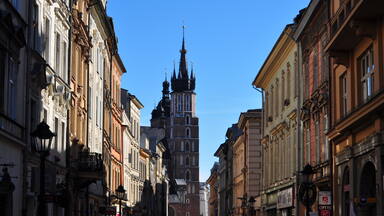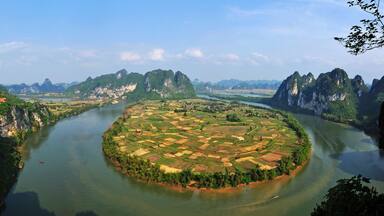Zuojiang Huashan Rock Art Cultural Landscape
Zuojiang Huashan Rock Art Cultural Landscape
Located on the steep cliffs in the border regions of southwest China, these 38 sites of rock art illustrate the life and rituals of the Luoyue people. They date from the period around the 5th century BCE to the 2nd century CE. In a surrounding landscape of karst, rivers and plateaux, they depict ceremonies that have been interpreted as portraying the bronze drum culture once prevalent across southern China. This cultural landscape is the only remains of this culture today.
Description is available under license CC-BY-SA IGO 3.0
Paysage culturel de l’art rupestre de Zuojiang Huashan
Situés sur des falaises abruptes dans les régions frontalières du sud-ouest de la Chine, ces 38 sites d’art rupestre illustrent la vie et les rituels du peuple Luoyue. Ils datent d’une période s’étendant des alentours du Ve siècle av. J.-C. au IIe siècle de notre ère. Ils s’inscrivent dans un paysage constitué de karst, de rivières et de plateaux, et donnent à voir des cérémonies qui ont été interprétées comme représentant la culture des tambours de bronze, autrefois dominante dans la Chine méridionale. Ce paysage culturel est aujourd’hui le seul témoin de cette culture.
Description is available under license CC-BY-SA IGO 3.0
مواقع فن النحت الصخري في زوجيانج هواشان
source: UNESCO/CPE
Description is available under license CC-BY-SA IGO 3.0
左江花山岩画文化景观
source: UNESCO/CPE
Description is available under license CC-BY-SA IGO 3.0
Paisaje cultural de arte rupestre de Zuojiang Huashan
Formado por 38 sitios de arte rupestre que ilustran la vida y los ritos del pueblo luoyue, este paisaje cultural está situado en la frontera sudoriental de China y se extiende por un territorio de farallones abruptos, terrenos kársticos, ríos y mesetas. Ejecutadas entre el siglo V a.C. y el siglo II de nuestra era común, las pinturas parietales de esos sitios muestran ceremonias que se consideran vinculadas a la cultura de los tambores de bronce, antaño predominante en el sur de China meridional. Este paisaje cultural es hasta ahora el único testimonio que se posee de esa cultura.
source: UNESCO/CPE
Description is available under license CC-BY-SA IGO 3.0
左江花山のロック・アートの文化的景観
source: NFUAJ
Zuojiang Huashan Rotskunst Cultureel Landschap
Source: unesco.nl
Outstanding Universal Value
Brief synthesis
Dating from around the 5th century BCE to the 2nd century CE, 38 sites of rock art and their associated karst, riverine and tableland landscape depict ceremonies that have been interpreted as portraying the bronze drum culture once prevalent across southern China. Located on steep cliffs cut through the karst landscape by the meandering Zuojiang River and its tributary Mingjiang River, the pictographs were created by the Luoyue people illustrating their life and rituals.
Criterion (iii): The Zuojiang Huashan Rock Art Cultural Landscape, with its special combination of landscape and rock art, vividly conveys the vigorous spiritual and social life of the Luoyue people who lived along the Zuojiang River from the 5th century BCE to the 2nd century CE. It is now the only witness to the tradition.
Criterion (vi): The images of Zuojiang Huashan depicting drums and related elements are symbolic records directly associated with the bronze drum culture once widespread in the region. Today bronze drums are still respected as symbols of power in southern China.
Integrity
The components of Zuojiang Huashan are relatively complete geographical spatial units, preserving the cliffs bearing the rock art, rivers forest and tablelands. The 38 rock art sites were selected as the best preserved pictographs representing all phases of development. The property contains all the elements necessary to convey the value of the cultural landscape and rock art and does not suffer from development or neglect.
Authenticity
Each site enclosed by mountains and rivers has preserved the rock art in its folds for over 2000 years. The location and setting of the rock art is authentic. The rock art is generally located high up on the cliffs, revered by the local inhabitants and although subject to weathering over time is authentic in terms of materials and substance. The motifs and figures of the rock art were related to the beliefs of the inhabitants of the area surrounding them. Today the painted mountains are revered by local people and rituals and sacrifices are performed to appease the invisible forces affecting their lives.
Protection and management requirements
One of the 38 rock art sites (Ningming Huashan) is protected at the National level in accordance with the National Law on the Protection of Cultural Relics. The other 37 are all protected at the Provincial level. The remainder of the property is protected by the provisions of Measures of Guangxi Zhuang Autonomous Region on the Protection of Zuojiang Rock Art and the Measures of Chongzuo City on the Protection of Zuojiang Rock Art, together with other laws and regulations which protect the scenic areas, waterways and farmlands, as well as customary village regulations for the protection of rock art in their vicinity. The buffer zones are protected by the regulations of the Construction Control Zone pursuant to the National Law on the Protection of Cultural Relics. Soon all 38 rock art sites will be placed under National level protection.
Overall management of the property is the responsibility of the Chongzuo Management Centre in Chongzuo City, which oversees the management measures and systems of the subordinate district and county administrative departments under which the three property components fall.
The Master Plan for the Conservation and Management of Zuojiang Huashan Rock Art Cultural Landscape was approved and issued in January 2015 for implementation by the Chongzuo City People’s Government after consultation with expert committees and public participation. It prohibits all quarrying, sand mining, soil collecting, logging and road construction and controls all development within the property and buffer zone including in the villages, where it restricts the height of construction to 8 metres and area coverage to 150 square metres. It also controls the form, materials and colours of any new construction.



